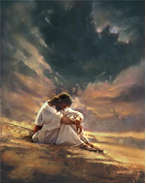 Study 5: Weeping over Jerusalem Study 5: Weeping over Jerusalem
Sermon Date: April 2, 2017
Reading: Luke 13: 31-35; Psalm 118:5-14
Background:
As we read the gospel, have you noticed how the closer that Jesus gets to Jerusalem, the clearer His teaching becomes about his identity, mission and the kingdom of God.
Before we begin our study, can I encourage you to read the preceding verses of Luke 13, noting verses 22-30 in particular. Due to the calendar, we’re unable to include these events in our sermon series. But they are important and put our study in context.
Along with many others, Jesus is walking towards Jerusalem to celebrate the Passover feast. This meal, also known as the Freedom meal, is shared by all Jewish people and commemorates how God, under the leadership of Moses, miraculously set his people from slavery under Pharaoh.
Jesus is travelling to Jerusalem not to celebrate the past freedom but to inaugurate freedom for all people through his death and resurrection on the Cross. He will become the Passover lamb.
Conversation Starter:
What places or situations today might make Jesus weep? Share your thoughts and also how as Christians we should respond?
Study:
1. (verse 31) Why do you think the Pharisees warned Jesus to flee from Herod?
2. How does Jesus respond to the news of Herod’s desire to kill him? What does this reveal?
3. What will happen “on the third day”? Notice that Jesus announces that this is his “goal.”
4. (verses 34 and 35). Who or what is Jesus lamenting and why?
5. Read verses 34 -35 again. How does Jesus describe himself and why do you think He does so in this way?
Action:
How has what you have considered today developed your faith and life in Christ?
How is the Holy Spirit inviting you to respond?
Helpful Hints for discussion questions:
1. Given the antipathy of the Pharisees for Jesus, their warning to Him is a surprise to us. Luke doesn’t reveal what their motivation was.
After Herod’s experience with John the Baptist, he may not have wanted the murder of another prophet on his conscience but he wanted to get rid of Jesus. So, Herod may have used the Pharisees to pass on the death threat in the hope of scaring him away.
Alternatively, the Pharisees may have been genuinely concerned for Jesus, because he was closer to them than Herod. Indeed, the scriptures tell us that even amongst the Pharisees, Jesus had his followers, for example Nicodemus (John 3:1-2, John 7:40-51, John 19:38-42). What is certain, given his past actions, Herod was a credible threat to the life of Jesus.
2. Jesus is unperturbed, defiant and insults Herod. A fox is a sly and cunning predator. In the time of Jesus, the symbol of the fox was used by the Jews for a person who was sly, insignificant and worthless. Herod was the rich puppet ruler of the area installed and maintained by the Romans. Referring back to Jesus’ previous teaching about salvation (Luke 13: 30), Herod is an example of one of the “first” who will be the “last”. He may sit in power and authority now but it is temporary.
Jesus considers Herod to be a sly, cunning and worthless ruler. A fox is a contrast to a majestic animal like a lion – and Jesus is the lion of Judah (Revelation 5:5).
Reading the gospels, Herod is the only person who is recorded as being treated by Jesus with contempt. Later we read that Herod wanted to see Jesus perform a miracle and that when Jesus stood before him, he said nothing (Luke 23: 8f). When Jesus has nothing to say to a person, this tells us that their position before him is hopeless.
An application follows from this description. Disciples need to be aware that Satan can/does operate like a fox so we need to be alert and confident in Christ.
3. Jesus has just two more days of ministry before arrest, trial and execution. This is his goal that he is about to achieve. Also, notice in verse 33, the urgency in Jesus’ voice and his commitment to honouring the will of God the Father. Jesus will complete the divine plan to bring salvation and God, not Herod, will determine when he will die.
His reference to the third day also points forward to his resurrection from the dead through which the sins of humanity are forgiven so that through faith in Jesus, we may receive forgiveness and live new life in God’s family.
4. This is the first of four laments for Jerusalem in Luke's Gospel (13:31-35; 19:41-44; 21:20-24; 23:27-31). Recognising what is to come, Jesus now reveals his love and humanity. He’s not frightened of Herod or his death but his heart is broken for the people of God who live without God. Jesus is distraught that the people’s successive rejection of him and the messengers of God sent in the past must now lead to what is to come.
Note: the repetition of a name often signifies painful grief or great frustration (see 2 Samuel 18:33; Luke 10:41; 22:31).
Can you imagine how Jesus was feeling at this time?
5. The words that Jesus uses to describe himself are intriguing. Herod is “the fox” while Jesus describes himself as “the hen”.
A hen gives gives life and protects and provides for her young. A hen is tender. Although a hen may be thought to be vulnerable there are anecdotal stories attesting to how strongly and successfully a mother hen protects her young under her wings.
Through this imagery, Jesus reveals his yearning to save his people from death and sorrow at their rejection which will led to their fate – “…you were not willing.” (verses 34-35)
|